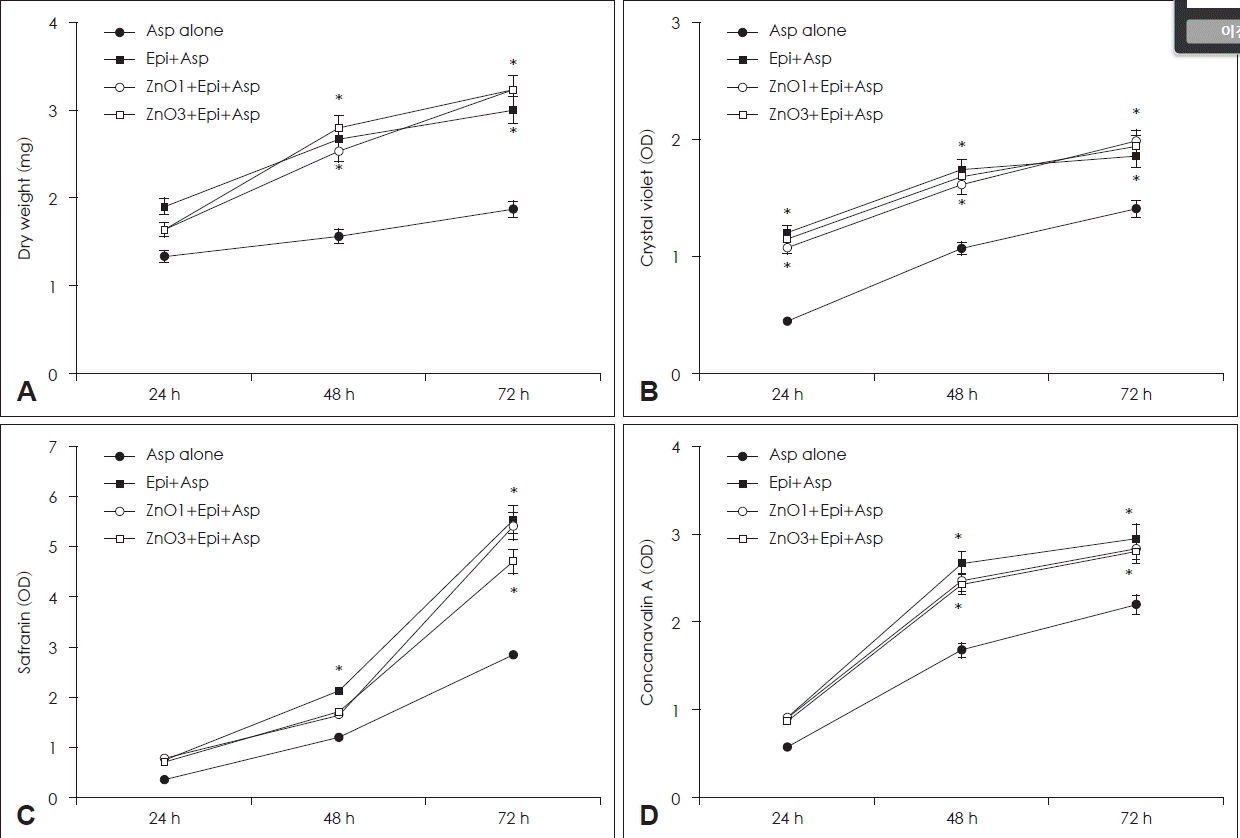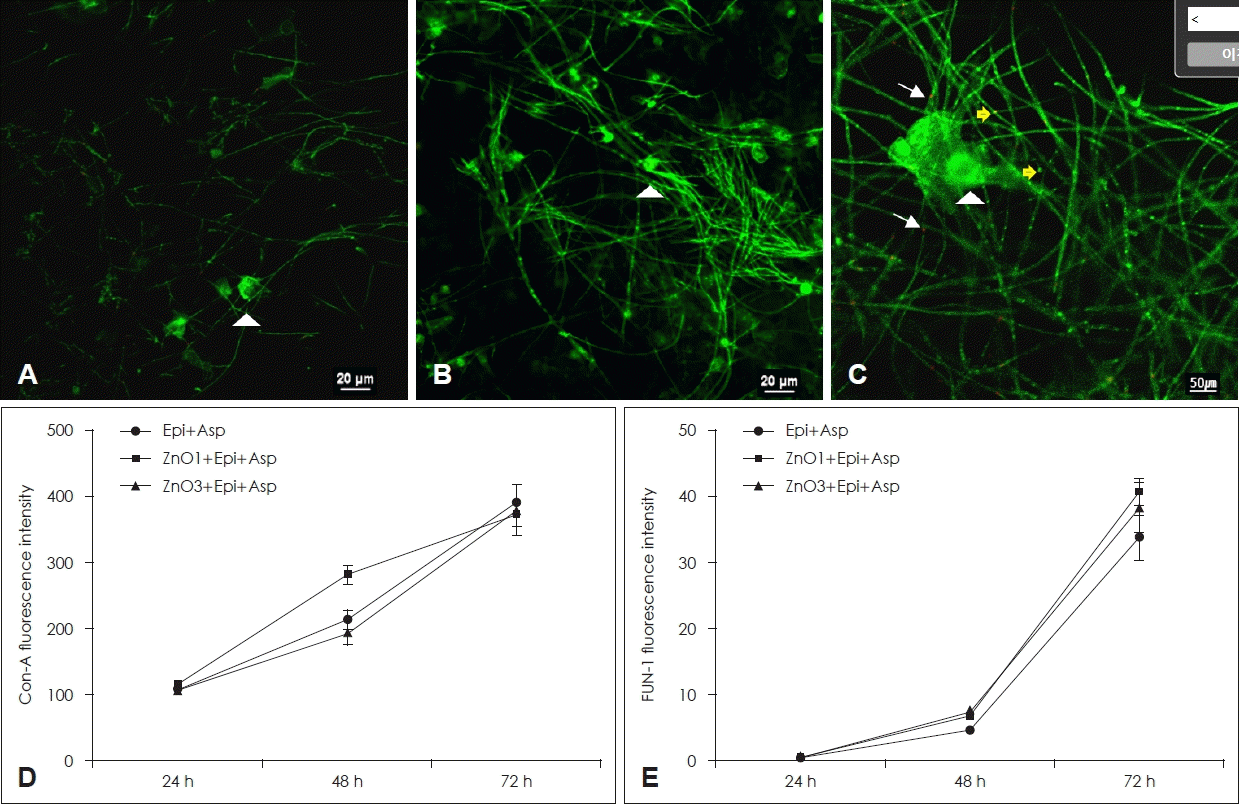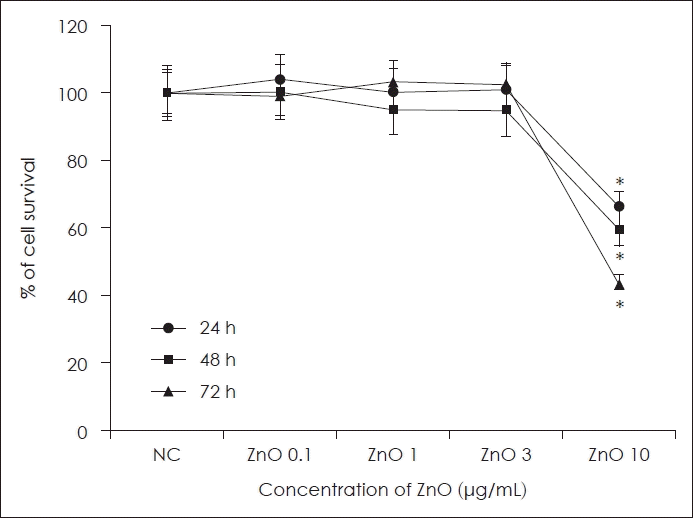Introduction
Subjects and Method
Preparation of A. fumigatus spores
Coculturing primary human nasal epithelial cells and A. fumigatus
Cell proliferation assay
Detection of interleukin (IL)-6, IL-8, and transforming growth factor (TGF)-β1
Biofilm dry weight
Biofilm quantification
Detection of an extracellular matrix of fungal biofilm
Biofilm confocal scanning laser microscopy
Statistical analysis
Results
Cytotoxic effect of ZnO on primary human nasal epithelial cells
Production of chemical mediators by A. fumigatus
 | Fig. 2.Effect of ZnO and Asp on chemical mediator production in primary human nasal Epi. A. fumigatus enhanced IL-6, IL-8 and TGF-β1 protein production. After 48 h and 72 h incubation with 1 and 3 μg/mL ZnO, IL-8 protein production was significantly decreased. *p<0.05 compared with NC; †p<0.05 compared with Asp+Epi group, n = 7. NC, negative control; Asp, Aspergillus fumigatus; Epi, epithelial cells; ZnO, zinc oxide; IL, interleukin; TGF, transforming growth factor. |
Effects of ZnO on the A. fumigatus biofilm formation
 | Fig. 3.Quantification of Asp biofilm in coculture of ZnO on the primary human nasal Epi. primary human nasal epithelial cells enhanced the development of fungal biofilm in compared with A. fumigatus culture without primary human nasal epithelial cells (Asp alone). However, coculturing of ZnO and A. fumigatus on primary human nasal epithelial cells did not affect biofilm dry weight (A), optical density for crystal violet (B), safranin (C), and concanavalin-A (D) staining. Epi+Asp: culture of Asp on the primary human nasal epithelial cells. ZnO1+Epi+Asp: culture of Asp with 1 μg/ml of ZnO on the primary human nasal epithelial cells, ZnO3+Epi+Asp: coculture of Asp with 3 μg/mL of ZnO on the primary human nasal epithelial cells, *p<0.05 compared with Asp alone, n=7. Asp, Aspergillus fumigatus; Epi, epithelial cells; ZnO, zinc oxide; OD, optical density. |
Confocal scanning laser microscopic findings of A. fumigatus biofilm
 | Fig. 4.Confocal scanning laser microscopy findings of Asp treated with ZnO. A-C show the representative confocal scanning laser microscopic findings after 48 hours. A. fumigatuson the epithelial cells (A, ×60 magnification), A. fumigatus with 1 μg/mL of ZnO (B, ×60 magnification), A. fumigatus with 3 μg/mL of ZnO (C, ×100 magnification). The arrowhead indicates Con-A stain binding to the fungal cell wall, the arrows indicates FUN-1 stain binding to metabolically active fungus, and yellow arrows indicate dual staining. Although ZnO did not affect fluorescence intensity of Con-A (D) and FUN-1 (E), Con-A and FUN-1 fluorescent intensity increased in a time-dependent manner. Epi+Asp: culture of Asp on the primary human nasal epithelial cells, ZnO1+Epi+Asp: culture of Asp with 1 μg/mL of ZnO on the primary human nasal epithelial cells, ZnO3+Epi+Asp: coculture of Asp with 3 μg/mL of ZnO on the primary human nasal epithelial cells. Epi, epithelial cells; Asp, Aspergillus fumigatus; ZnO, zinc oxide; Con-A, concanavalin A. |




 PDF
PDF Citation
Citation Print
Print




 XML Download
XML Download